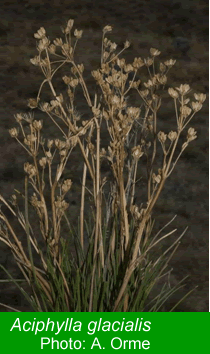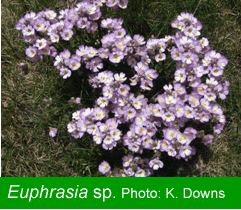
Summary of final report on the Australian Flora Foundation funded project:
Amelia J. Martyn, Karen D. Sommerville and Catherine A. Offord
The Australian Botanic Garden, Mount Annan, New South Wales
Grant Details Final Report
While the distribution and general ecology of Australian high-altitude species is increasingly well-studied, little is known about the seed biology of individual herbs. It is not known, for example, which species require low temperatures and/or cold stratification for germination and dormancy break, and whether these requirements would be fulfilled in a warmer climate. In this study, we investigated optimum temperatures for germination, and response to dormancy alleviating treatments of cold stratification and gibberellic acid (GA3), for 20 species collected from high altitudes (860-1960m elevation) in Kosciuszko National Park, south-eastern Australia. While many of these species occur generally only at relatively high altitude (e.g. Coronidiium waddelliae 1170-1500m), a number have wider distributions (e.g. C. scorpiodes 1-1300m).

Germination response to temperature was highly variable among species. Temperature ranges and optima with and without periods of stratification (4, 8, 12 weeks) were determined for each species. For example, without stratification, low temperatures (5-19°C) were optimal for germination of Aciphylla glacialis, Oreomyrrhis eriopoda and Arthropodium sp. B. Moderate temperatures were favoured by Brachyscome sp. 1 sensu P.S.Short (1999) and Epilobium gunnianum, while Wahlenbergia had a higher temperature optimum (25°C). The endemic, high altitude species Euphrasia collina ssp. diversicolor exhibited poor germination at all temperatures. Two species (Epilobium gunnianum and Oreomyrrhis eriopoda) germinated to some extent at all temperatures (10, 15, 20, 25°C, 20/5°C and 20/10°C). Cold moist stratification response was positive for seven species, while GA3 substituted for or improved upon cold stratification for Derwentia and Wahlenbergia. In general, the seven Asteraceae species germinated well at a wide range of temperature responses and showed little or no response to stratification or GA3, with the exception of C. waddelliae which had faster germination after stratification.
This information was synthesized to determine the dormancy status of the species collections. Ten species appeared to be non-dormant, although there were indications of a degree of physiological dormancy in several. One species had deep physiological dormancy (Viola bentonicifolia) and another had physical dormancy (Acacia pravissima). The type and depth of morphophysiological dormancy varied for the other seven species (Aciphylla glacialis, A. simplicifolia, Oreomyrrhis erriopoda, Wahlenbergia ceracea, W. gloriosa, Derwentia perfoliata) including one which was deeply dormant (Euphrasia collina ssp. diversicolor).
Understanding the germination response to temperature has the potential to improve models of species response to pressures such as climate change and improve seed utilisation for rehabilitation, as well as clarify seed germination requirements for conservation seed banks and restoration.
